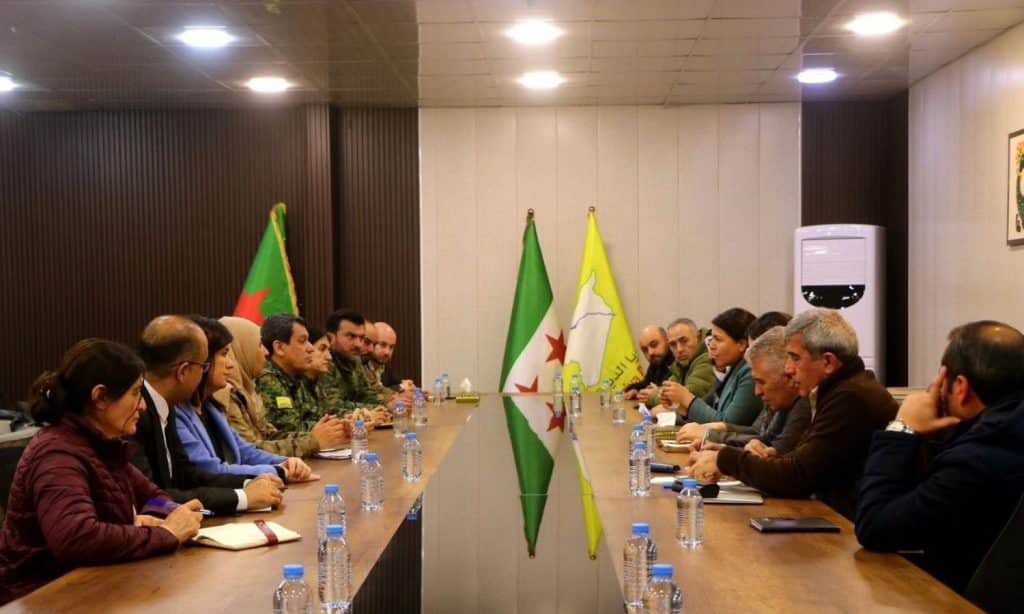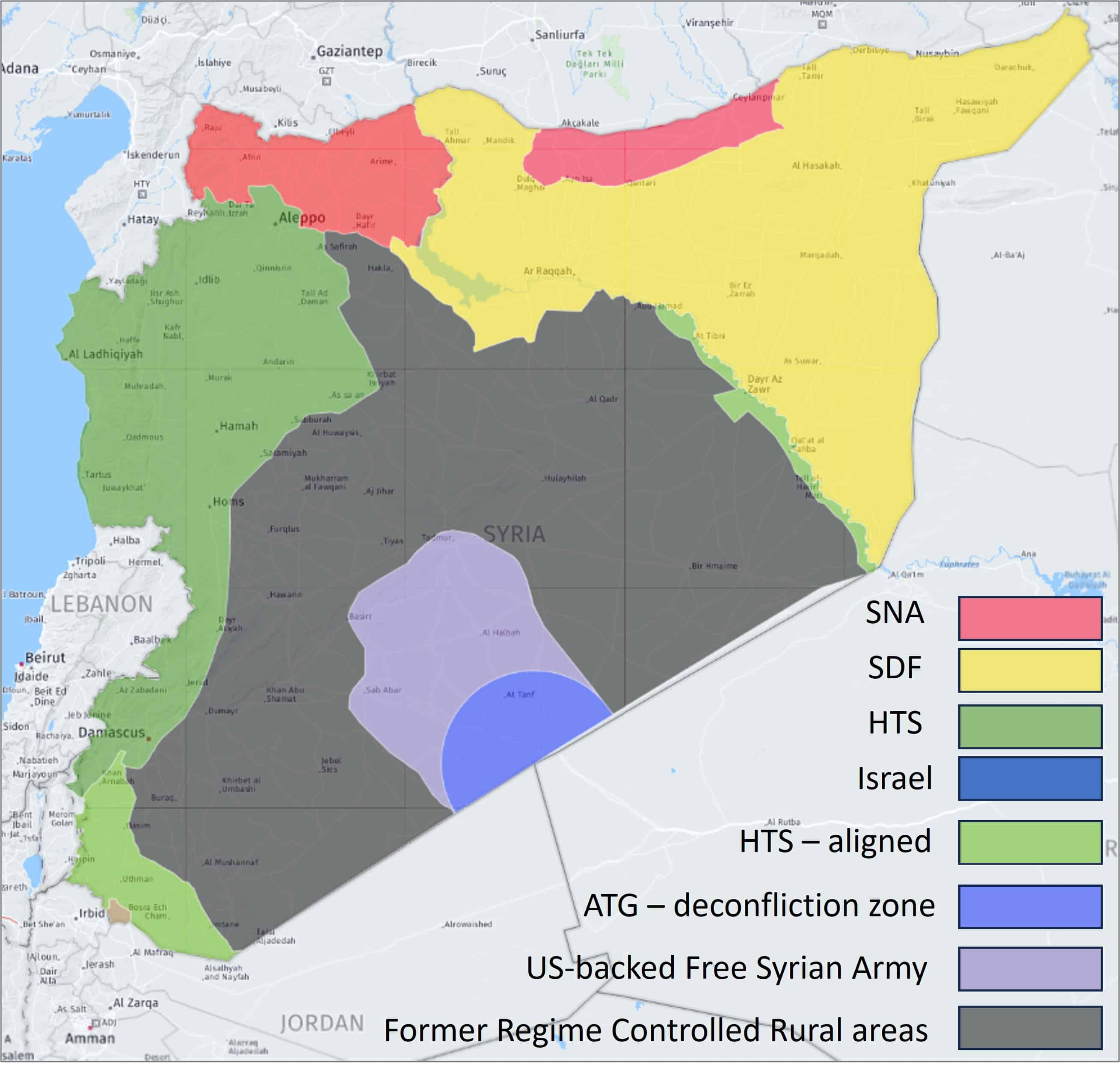NATIONAL OVERVIEW
Nationwide incidents
SIGNIFICANT EVENTS
- SDF Commander congratulates President al-Sharaa and welcomes dialogue
- Northern Brigade Commander says SDF will integrate into new Syria Army
- UAV attack against Russian airbase in Latakia
- Security operations and extrajudicial activity reported in Damascus
- Grenade attack, stabbing and demonstration reported in Damascus city
- Security operations in countryside target criminality
- Limited reports of Israeli airstrikes in Suwayda province
- Clashes in Suwayda linked to localized dynamics
- Anti-government protests reported in Suwayda city
- Turkish-backed SNA and SDF exchange artillery and airstrikes in eastern Aleppo and Raqqah
- Ceremonial gunfire during funeral of IRGC commander in Deir Ez Zour
- Internal Security Forces target former regime remnants in Deir Ez Zour province
- Attack by former regime remnants in Hama province
- Criminal activity affecting villages in Hama province
- Sectarian violence reported in Tartous countryside
STRATEGIC AND POLITICAL DEVELOPMENTS
SDF Commander congratulates President al-Sharaa and welcomes dialogue
In a speech held on 17 February, the Commander-in-Chief of the Syrian Democratic Forces (SDF), Mazloum Abdi, addressed the SDF’s current relations with the interim government in Damascus amidst the ongoing political transition and as preparations for the upcoming National Dialogue Conference continue. Striking a conciliatory tone, Abdi most notably congratulated al-Sharaa on assuming the presidency and expressed hope that al-Sharaa would successfully lead the country through this critical period. Abdi also emphasized the SDF’s support for any efforts that contribute to achieving stability and national unity in Syria. Moreover, the commander confirmed that negotiations between the SDF and the new government are currently ongoing and that both sides are committed to resolving outstanding issues through dialogue and communication.

Meeting within the SDF on 17 February
Abdi also praised al-Sharaa’s recent visit to Afrin – the Kurdish-majority city that the president visited over the weekend – as “an important initiative” to encourage the safe return of the indigenous population and enhance dialogue. The commander also called on al-Sharaa to visit other cities in the northeastern parts while welcoming any invitations to Damascus to further the dialogue between the two sides.
The speech marks a significant shift in tone from the SDF and represents a significant outreach to the government, and a willingness to engage over pressing matters. Only days earlier, the SDF strongly criticized the new government for omitting Kurdish representation in the preparatory committee set up to organize the National Dialogue Conference and for excluding the SDF from participating in the conference itself.
Northern Brigade Commander says SDF will integrate into new Syria Army
In a related, significant development on 18 February, Abu Omar al-Idlibi – the commander of the SDF-affiliated Northern Democratic Brigade – announced on his social media platform that the SDF agreed to integrate into the new Syrian Army in a meeting on 17 February. The post outlined eight points that were agreed to in the meeting including:
- A decision was made to integrate the security institutions affiliated with the SDF and the Autonomous Administration into the Syrian Army’s structure to strengthen national unity and defense capabilities.
- Efforts will be made to restore the operation of state service institutions in northeastern Syria, ensuring the provision of essential services and improving local residents’ living conditions.
- The withdrawal of all foreign fighters from the SDF and northeastern Syria is considered a crucial step toward reinforcing national sovereignty and maintaining regional stability.
- Expanding coordination with the Syrian government and increasing the frequency of meetings to discuss key national matters.
- Stressing the importance of maintaining Syria’s territorial integrity and incorporating local forces into the Syrian army to bolster the nation’s defense capacity.
- Creating the necessary conditions to support the return of refugees and displaced individuals to their hometowns and communities.
- Extending congratulations to President Ahmed al-Sharaa on his new role and officially inviting him to visit northeastern Syria.
- Forming joint committees to oversee the implementation of decisions and ensure their effective execution.
As of 18 February, the SDF has not officially confirmed or commented on the post, which is consistent with Abdi’s speech on 17 February but marks an even clearer step toward engagement and integration. The decision to integrate with the new Syrian Army is the most striking and potentially significant factor, yet it should be stressed that the manner and circumstances under which the SDF is willing to integrate remain unclear. To recall, the SDF has already tentatively agreed to integration but only as an independent military bloc – a demand rejected by the interim government so far. The government has also demanded that the SDF hand over control of camps hosting former IS members and the “reinstatement of central government institutions in northern and eastern Syria”. In his interview on 17 February, Abdi said the SDF is willing to cooperate and discuss these issues, but without claiming that the SDF is willing to accommodate Damascus yet.
UAV attack against Russian airbase in Latakia
Shortly after midnight on 18 February, media sources close to Iran reported that anti-aircraft units at the Russian base in Hmeimim Airport, Jableh, Latakia countryside, repelled a drone attack in the airport’s airspace. Video footage disseminated on pro-Iranian telegram channels displayed the apparent interception of three UAVs near the airbase. Other pro-Russian accounts stated that the UAVs were intercepted by the Russian Pantsir missile defense system and blamed the HTS for conducting the attack yet this remains unconfirmed at this stage.
As of writing, the Syrian government and Russian officials have not commented on the attack, and details remain limited. Some sources said the UAVs followed clashes between the HTS and unidentified individuals near the airport, prompting the HTS security forces to deploy drones to support a security operation in response. The drones were then shot down by the Russian forces however this version of the events also remains unverified as of writing. It is worth noting that the attack coincides with reports that the Syrian and Russian governments are close to an agreement that would allow Russia to retain a military presence in Syria. If confirmed, the UAV strikes are plausibly linked to efforts by some elements to sabotage the agreement, yet this too remains speculative absent further details and confirmation.
DAMASCUS & THE SOUTHERN REGION (including Suwaida, Daraa & Quneitra)
Security operations and extrajudicial activity reported in Damascus
Noteworthy activity in the capital included two separate security operations conducted by the HTS and affiliated individuals. On 17 February, various reports stated that the Public Security Service launched a security operation in the Tadamon area of Damascus City. Damascus Security Director Lt. Col. Abdul Rahman Al-Dabbagh announced the arrest of a leader involved in the Tadamon massacre 12 years ago. Initial investigations led to the arrests of two additional participants. The detainees confessed to their roles in the massacre, which resulted in the deaths of over 500 civilians. Authorities are working to locate the massacre sites and prosecute those responsible.
Separately, local sources reported that HTS-affiliated groups were forcibly seizing homes in Harasta, a suburb of Damascus, and expelling residents without allowing them to retrieve their belongings. These actions were reportedly carried out without official authorization or justification. Other sources claimed the forced removals were conducted for “sectarian reasons” but without specifying.
The circumstances remain unclear yet this follows similar reports of forced removals and extrajudicial activity targeting residential areas in the city since the fall of the Assad regime. This has included the forced removal of families and individuals affiliated with the former government, and government employees, police officers and members of the security forces who were afforded housing by the former government. So far, this activity has not resulted in any major acts of violence, but protests in response to these activities have been recorded.
Grenade attack, stabbing and demonstration reported in Damascus city
Other activity in the city included incidents of violence linked to localized dynamics. On 17 February, an individual detonated two grenades in the Kashkul area of Damascus, resulting in one individual sustaining severe injuries. One source stated that the victim was a displaced person who had just arrived in the area yet the exact motivation behind the attack remains unclear. Separately, a woman fatally stabbed a young woman at a flower shop where she worked in the Zour Ava neighborhood of Damascus City. The motive for the attack was not disclosed but a personal dispute is strongly suspected.
Protest activity in the city was limited overall but included one demonstration by students. On 17 February, social media sources reported that students of the Higher Institute of Cinematic Arts in Damascus City declared a strike and initiated a protest in front of the institute, demanding the replacement of the dean and reforms in the educational process. No violence or disruption was noted in connection with the event.
Security operations in countryside target criminality
Activity in the provincial areas of Damascus comprised security operations targeting criminality. On 17 February, an unnamed security source reported that members of an armed group, accused of being involved in several robberies, were arrested in Hussainiya City, Damascus countryside. The authorities seized a sum of money, gold jewelry, and various weapons in their possession. Separately, the Internal Security Service confiscated approximately half a ton of smuggled drugs on the Syrian-Lebanese border in the Sarghaya area, Damascus countryside. The drugs had been smuggled from Lebanon into Syria and the operation was reportedly conducted in coordination with the Lebanese security forces.
Limited reports of Israeli airstrike in Suwayda province
On the evening of 17 February, social media sources claimed that an Israeli airstrike targeted Khalkhala Military Airport in northern As Suwayda province. No further details were reported and the incident has not been widely discussed. That said, the incident is assessed as plausible in light of standing efforts by Israel to limit and neutralize remnant army capabilities in the country by targeting military facilities and military airports.
Clashes in Suwayda linked to localized dynamics
On the evening of 17 February, explosions and gunfire were reported in the Maqwas area of As Suwayda City. Reports indicated the use of heavy machine guns and mortars. Media outlets affiliated with the Mountain Brigade, a Druze-affiliated force, stated that an armed group opened fire on their members when they intervened in a dispute at a carpet factory in Maqous. They claimed that subsequent violence was an individual act unrelated to their members and called on local tribes to hand over the shooters.
In the countryside, on the evening of 17 February, social media sources reported clashes near Umm Haratin village in the northern countryside of As Suwayda province. The conflict began after a group from outside the village attempted to steal high-voltage cables from the main power line, which had been out of service for over a year. The clashes lasted for more than an hour, with no reported casualties.
Anti-government protests reported in Suwayda city
Anti-government sentiments were also on display in the province when, on 17 February, local sources reported that dozens of people demonstrated in As Suwayda City. The protesters criticized the policies and plans by the government in Damascus and called for decentralization while rejecting efforts to integrate the Druze minority under Damascus authority. They also emphasized the need for a governance system that reflects Syria’s diversity and allows independent decision-making for its communities. The demonstration unfolded peacefully but is noteworthy in the context of current efforts by the Interim Government to further a political transition based on centralization and integration of minority groups.
NORTH & EAST SYRIA (Including Hasaka, Deir Ez Zour, Aleppo & Raqqa provinces)
Turkish-backed SNA and SDF exchange artillery and airstrikes in eastern Aleppo and Raqqah
An intensification in the tempo of operations was noted over the review period in eastern Aleppo province where the SDF, Turkey and Syrian National Army continued to exchange artillery, UAV strikes and airstrikes over the review period. Like previous days, the fighting remains concentrated around the Tishreen Dam and Sarrin as well as areas just south of Kobani, yet no changes to the territorial control of terrain was assessed. According to local sources, Turkish forces carried out intensive artillery shelling targeting the vicinity of Tishreen Dam and Qarqozak Bridge while airstrikes were reported on multiple occasions on locations north and west of Sarrin City and Shuyukh town in the Kobani countryside. This coincided with an intensification in reconnaissance activity as well in the area preceding the operations. The outcomes of the strikes were not initially discussed.
For their part, the SNA-aligned Civil Defense reported that the SDF launched a rocket attack on civilian homes, side streets, shops, and a public facility in Khafsa town, Manbij district, eastern Aleppo province. The attack resulted in material damage only and no casualties.
A similar pattern of activity was reported in the Raqqa province. On the afternoon of 17 February, social media sources reported that a Turkish warplane conducted an airstrike targeting the SDF’s Sakiro base in the Ain Issa district, northern Raqqa province. Reports indicated that several SDF members were killed, with some sources claiming as many as 20 fatalities and wounded. The figure could not be confidently verified and is possibly exaggerated for political effect. SDF-linked media also reported that a Turkish UAV bombed the villages of Sakiro and Safwiya in the eastern Ain Issa countryside. No casualties were reported in those strikes.
Ceremonial gunfire during funeral of IRGC commander in Deir Ez Zour
On 17 February, the funeral of Abu Issa al-Hamdan, the commander of the Iranian-backed 47th Regiment militia, took place in Albu Kamal City, Deir Ez Zour province. The event was attended by members of his tribe and involved heavy gunfire for ceremonial purposes. Reports indicate that militants used Iranian-supplied weapons during the funeral. To recall, the body of al-Hamdan was founded earlier this week beheaded in the vicinity of albu Kamal, with his death prompting local protests and reactions.
Internal Security Forces target former regime remnants in Deir Ez Zour province
On 17 February, the Internal Security Forces (Asayish) of North and East Syria (NES) announced the arrest of several individuals linked to the remnants of the former regime in Deir Ez Zour province. In a statement, the Asayish reported conducting multiple security operations targeting these elements, during which weapons and ammunition were seized. The statement further said the detainees will be handed over to the judiciary to extract information regarding distribution networks and those involved in arms trafficking. The Asayish emphasized that their operations to disarm and eliminate what they described as “destructive phenomena” are ongoing. Additionally, they called on residents in areas controlled by the Democratic Autonomous Administration of North and East Syria (DAANES) in Deir Ez Zour to surrender all war weapons within three days, describing the deadline as final. The Asayish urged former regime elements to complete settlement processes to ensure regional stability and security.
CENTRAL REGION (Including Idlib, Hama, Latakia, Tartous, Hama & Homs)
Attack by former regime remnants in Hama province
Activity involving former regime sympathizers continues to be reported in Hama province. On the evening of 17 February, the Ministry of Interior reported that “remnants of the former regime” attacked a group affiliated with the Ministry of Defense on the Hayalin road in the Masyaf countryside, Hama province. Security patrols were dispatched to secure the area and no casualties were discussed. The identity of the perpetrators remains unknown and as of writing the Syrian Resistance group has not claimed responsibility for the attack.
Separately, local reports continue to emerge regarding arrest campaigns and extrajudicial violence targeting residents of villages associated with former regime support.. Most notably, local sources stated that armed factions affiliated with HTS stormed Baarin village in Masyaf district, Hama province. The faction reportedly launched an arrest campaign amid gunfire and sectarian insults directed at villagers. Simultaneously, activists in the area reported heavy gunfire in the countryside surrounding Masyaf, indicating an armed response to the initial “arrest campaign.” No casualties were discussed and no further tensions were reported since, but tensions are assessed as elevated in light of this.
Criminal activity affecting villages in Hama province
Other noteworthy activities included criminality and armed violence in the Hama countryside. On 17 February, four people were killed and others injured in Fayda village, eastern Hama province, during clashes with residents of Qanater village. The violence, involving light and medium weapons, was attributed to long-standing disputes and revenge conflicts involving local tribal elements.
Separately, local sources reported that an armed group attacked a house on the outskirts of Adbas village in western Hama province. Residents in the area then contacted the Public Security forces and a security vehicle arrived promptly, causing the group to flee. After the security forces withdrew, the armed group returned in a car and launched a second attack on the house. They tied up the homeowners, threatened to kill them, and proceeded to steal furniture, gold jewelry, solar panels, and an agricultural hoe, before fleeing the area. Such incidents of criminality are fairly commonly reported in the Hama countryside, illustrating a prevailing sense of lawlessness and the difficulties involved in implementing law enforcement in rural areas characterized by low levels of security.
Sectarian violence reported in Tartous countryside
In Tartous province, one act of sectarian violence was reported over the review period. On 17 February, social media sources reported that residents of Arab Al-Shati attacked Hamidiyah village in the Tartous countryside, allegedly for sectarian reasons. The attackers opened fire indiscriminately, injuring two civilians, both of whom were placed in intensive care.

